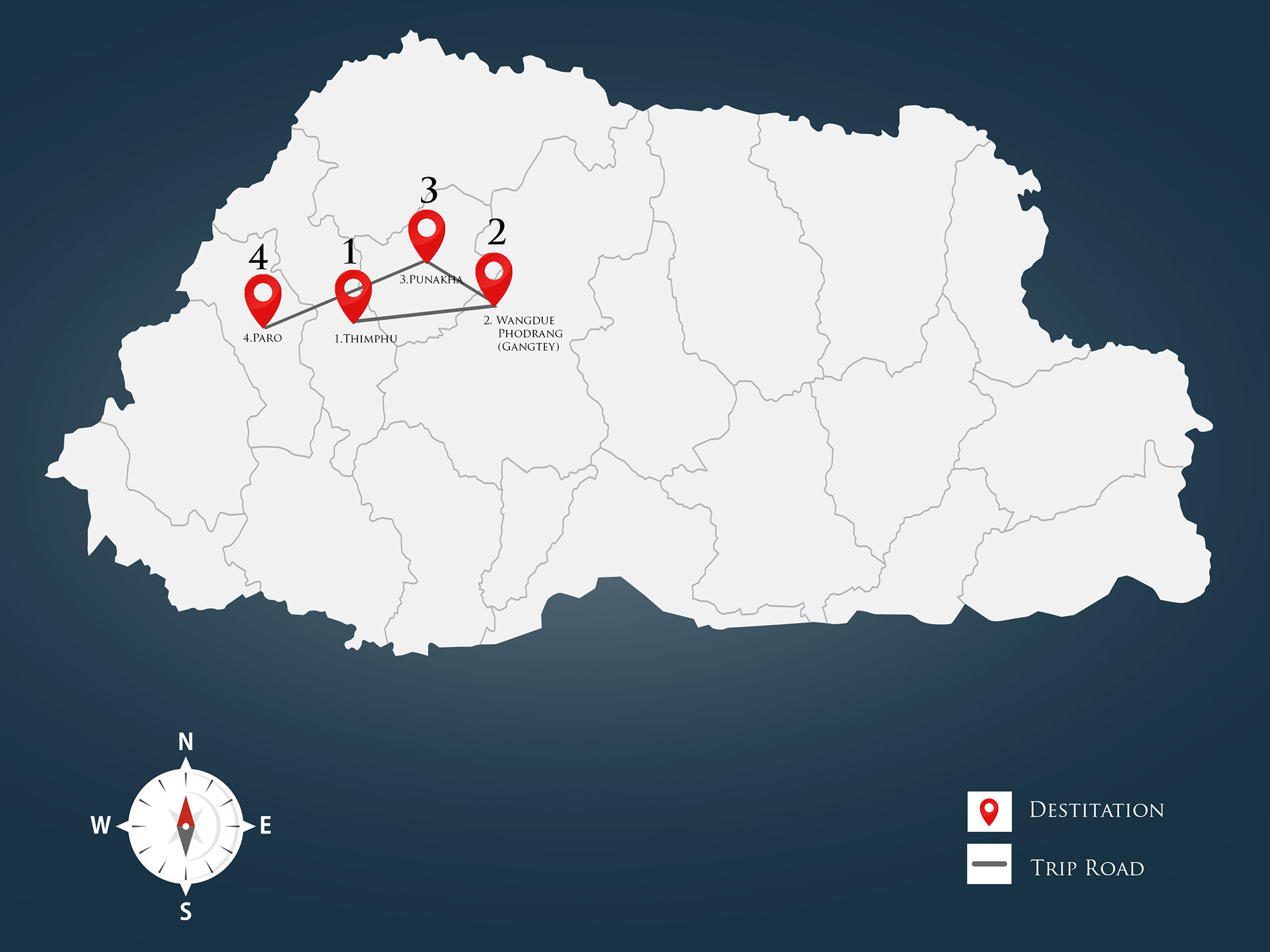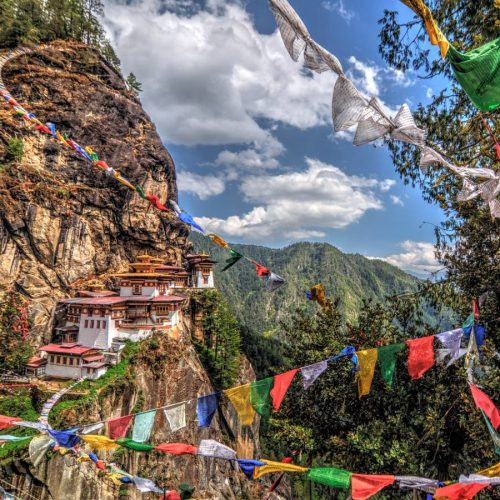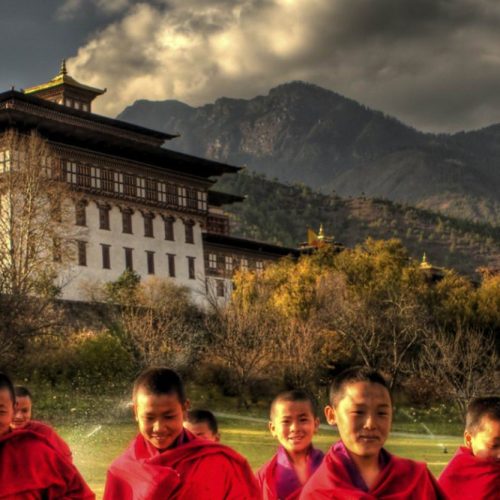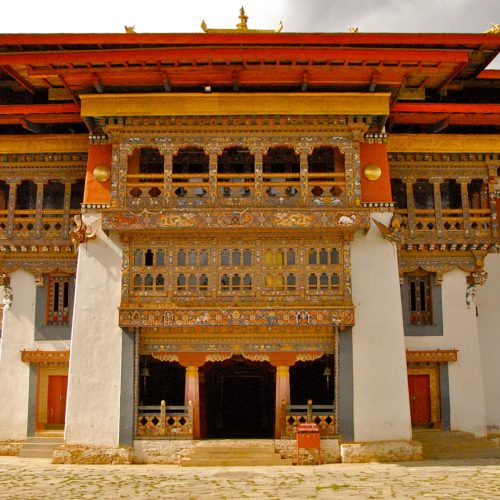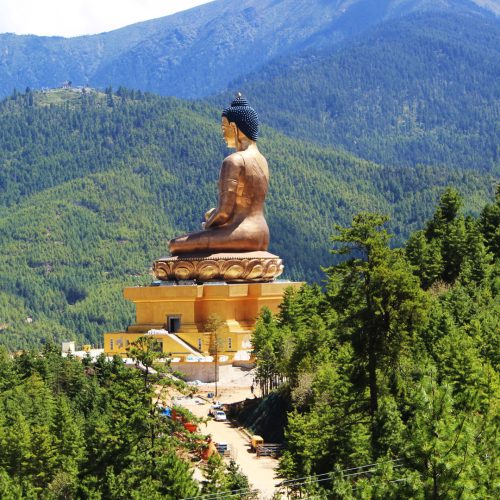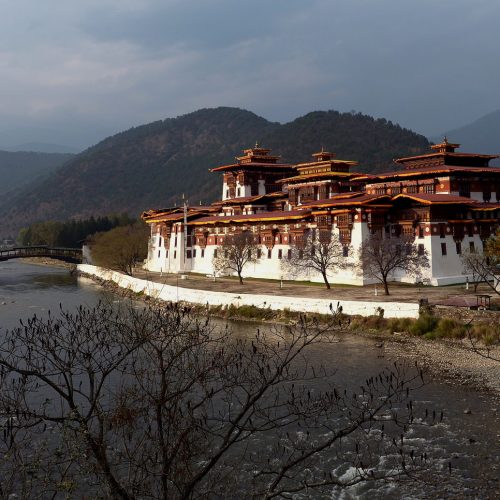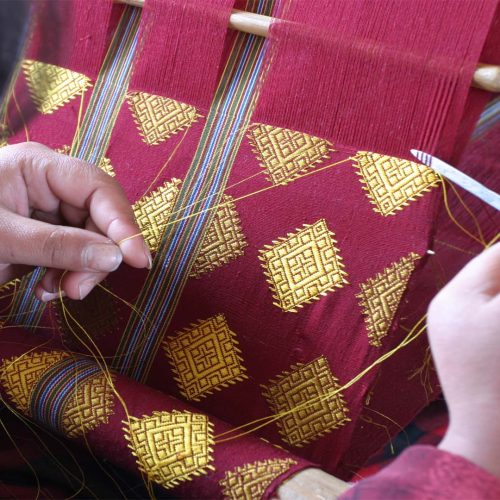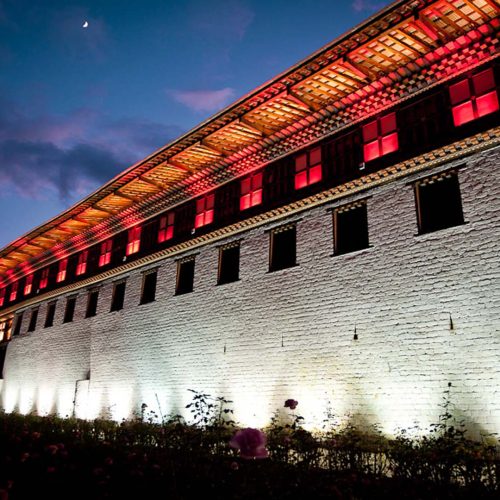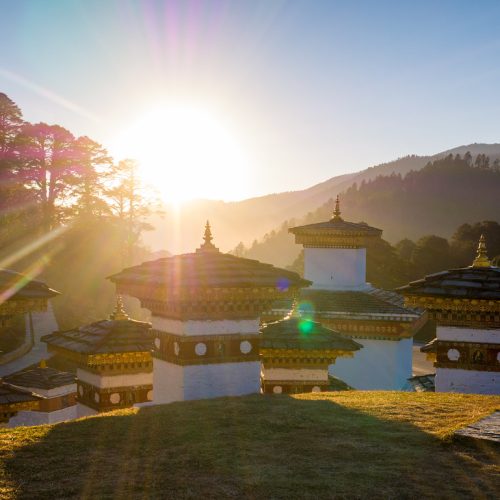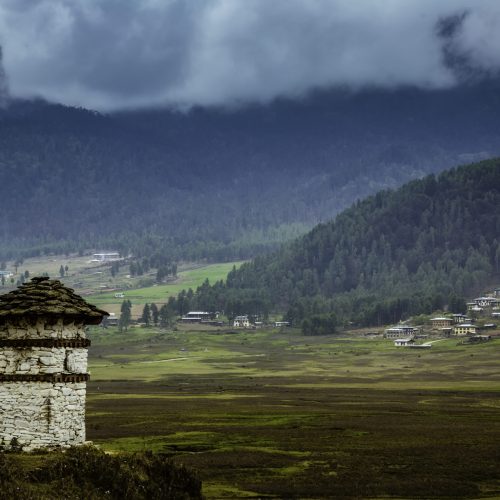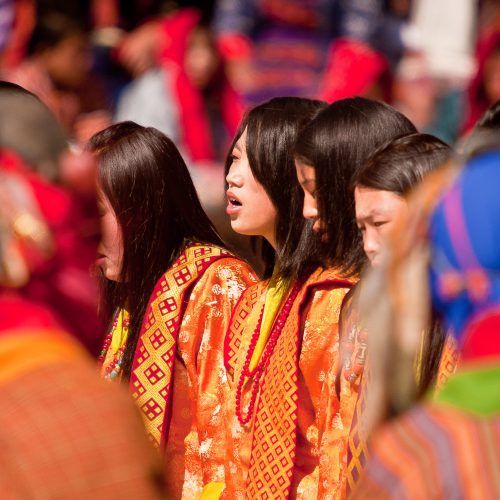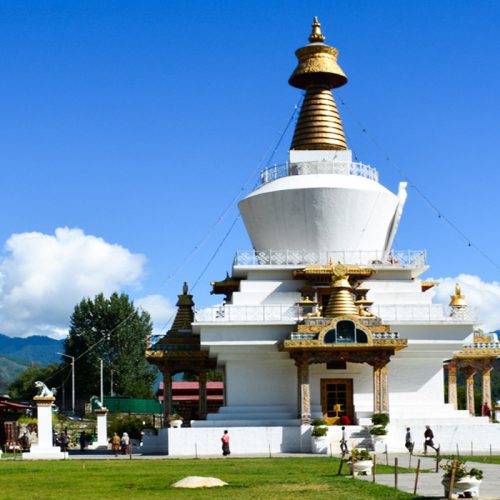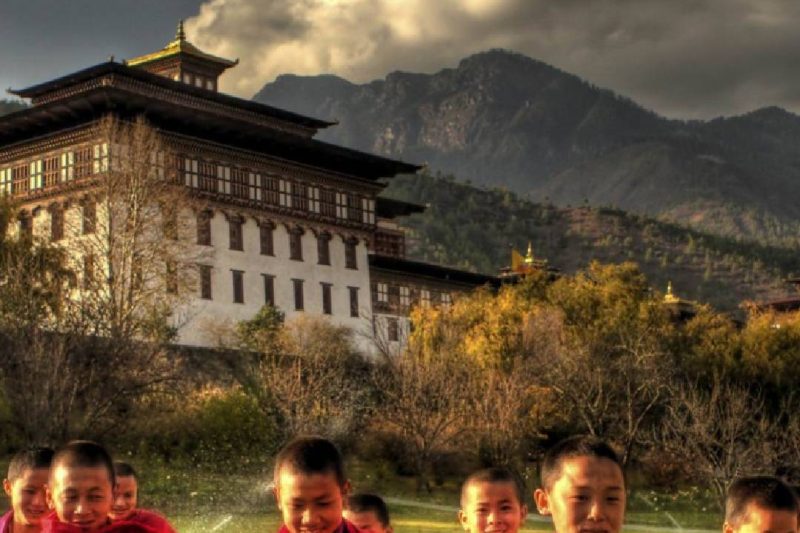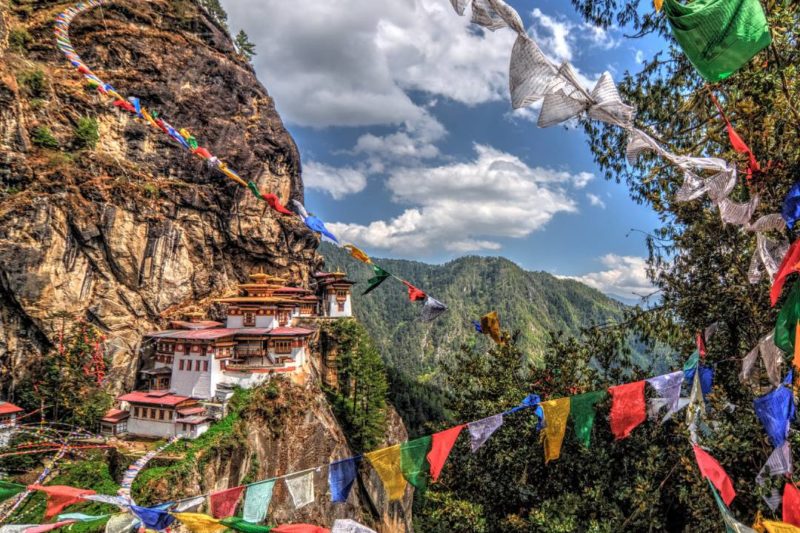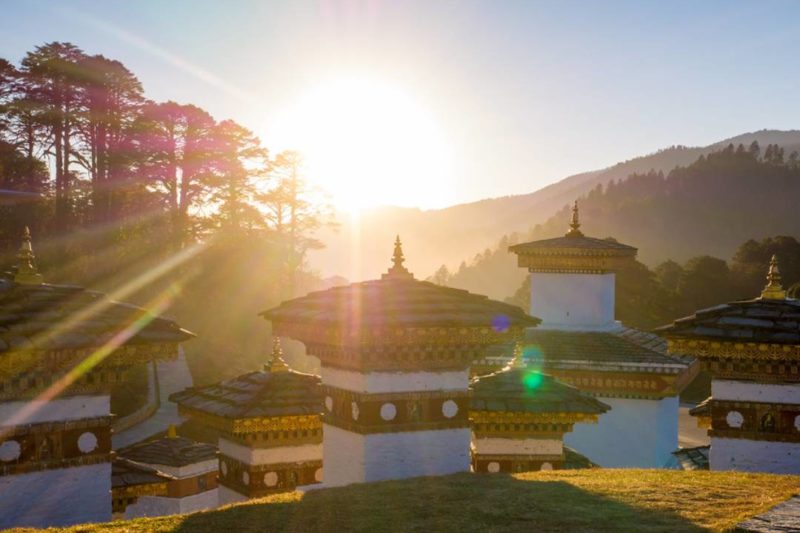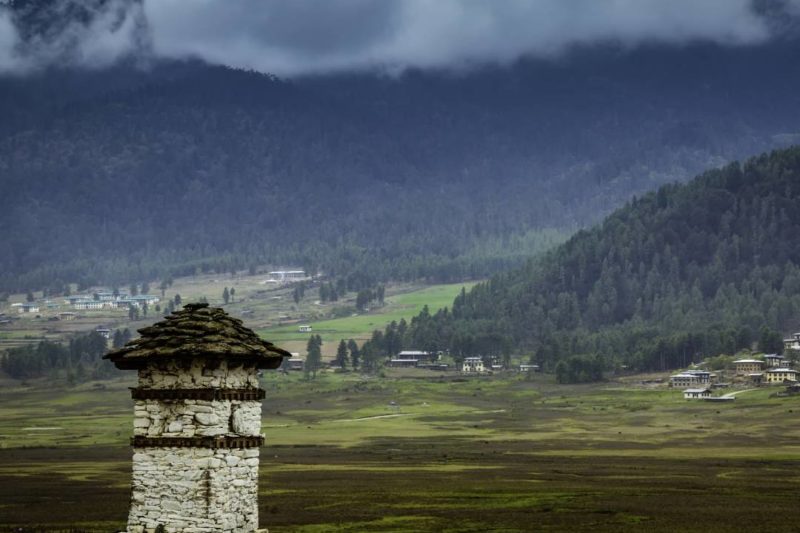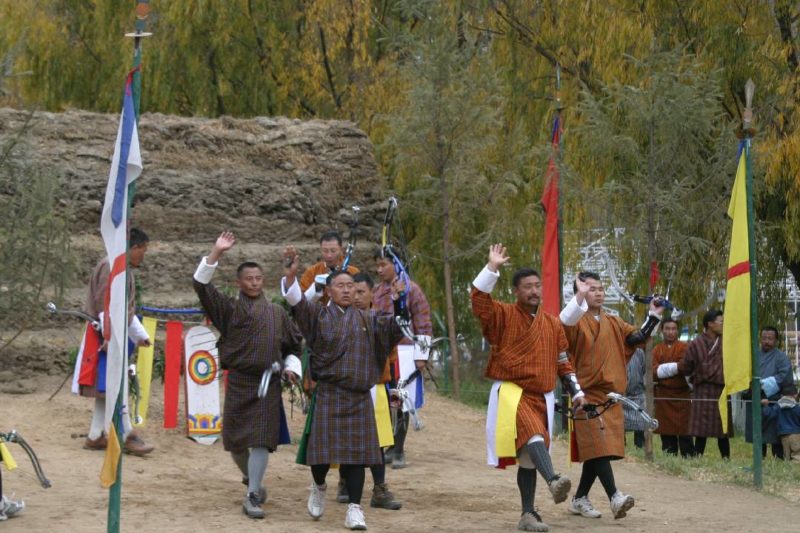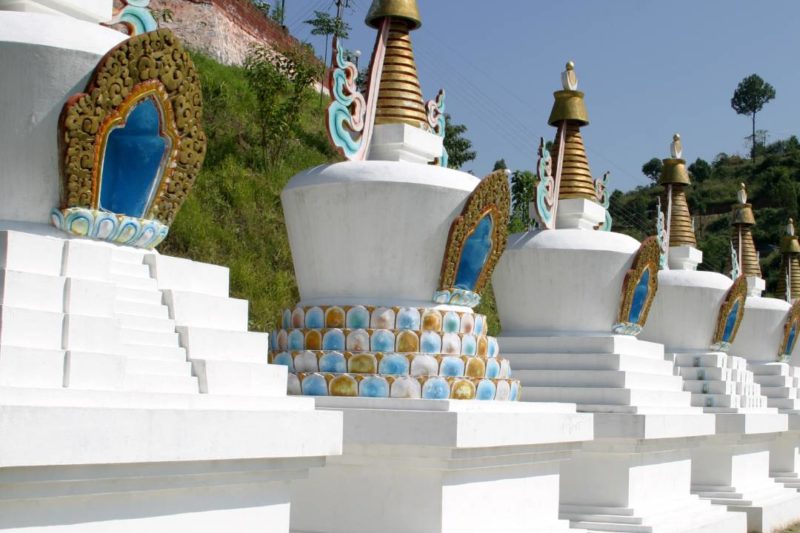A travel experience through the capital of Bhutan- Thimphu, Punakha – the old capital, and Paro valley. Highlights in this tour includes Punakha Dzong, “Palace of Great Happiness” and Paro Rinpung Dzong, “Fortress of The Heap of Jewels” finest examples of Bhutan’s unique architecture. An unforgettable experience and hike to Taktsang- The Tiger’s Nest. The Phobjikha Valley is one of the most beautiful destinations in Bhutan, a Unesco World Heritage Site. It is the winter home to a group of globally endangered black necked cranes that arrive every year from the Tibetan Plateau. Explore the vibrant atmosphere and daily hustle and bustle of Thimphu and Paro town while also experiencing spectacular views of the Himalayan range, its snowy peaks and the lush green forests Bhutan has to offer.
Altitude in Paro: 2,280m
Altitude in Thimphu: 2,320m
Distance: 55km
Estimated travel time: 1.30 hour
Onboard the aircraft, the flight is treated to spectacular views of snow peaked mountains and the Himalayan ranges. Paro airport (2,280m) is Bhutan’s only international airport where our dedicated team will then take you to the capital city Thimphu, an estimated one-and-a-half-hour drive of 55km.
Tachogang Lhakhang –This ancient temple was built by Thangtong Gyalpo, the Bhutanese legendary iron bridge builder. The story goes that Thangtong Gyalpo was inspired by the vision of the spiritual horse Balaha (an emanation of Chenrizig Avalokiteshvara) when he was meditating at the very same spot of the temple.
National Memorial Chorten – one of Bhutan’s most prominent buildings. The Chorten is the monument of world peace and prosperity. For Bhutanese, the site also serves as the memorial to their Third King, His Majesty Jigme Dorji Wangchuck (1928-72).
General Post Office - The office is loved by travelers since you can make your own stamp – the unique Bhutanese souvenir to send to your family and friends.
Centenary Farmers Market (weekends only)- Located below the main town, near the Wang Chhu River, Thimphu’s weekend market is by far the largest domestic market for the farmers in Bhutan.
Farmers come from all over the country to sell their farm products in the market. With its wide assortment of fresh and organic produce, the Farmer’s Market has become a favourite spot for tourists and a recreational place for people from all walks of life.
Buddha Point (Buddha Dordenma) - At a height of 51,5m, placed on top of a hill in Kuenselphodrang Nature Park, the sight of the enormous statue of Shakyamuni Buddha is stunning and unforgettable. This giant statue is one of the largest in the world and is said to emanate an aura of peace and happiness.
Wangditse hike- An enjoyable leisure hike of around 5km through oak and blue pine trees and rhododendron taking 2 hours to complete. Enjoy views of Thimphu city and it’s landmarks.
Mothithang Takin Reserve- A short distance up the road to the BBS tower viewpoint is a trail leading to a large, fenced enclosure that was originally established as a zoo. A chance to see Bhutan’s national animal- the Takin with a body of a cow and the head of a goat giving their unique look.
Altitude in Thimphu: 2,320m
Hike to Cheri Goemba – the first monastery of Bhutan (2,800m), established in 1620. The ancient monastery was founded by Ngawang Namgyal, the founder of Bhutan. An hour of hiking through forests of blue pine, fir, and rhododendron trees.
Folk Heritage Museum- get an insight into rural Bhutanese life and art.
National Textile MuseumThe heritage museum replicates a rural house in the mid-19th century, using rammed mud timber, presenting objects like the leopard-skin bags and Brokpa yak-hair ‘spider’ hats. The art of Thagzo (weaving) with different styles and on a variety of materials will also be presented.
National Institute for Zorig Chusum (The Arts and Crafts School or Painting school)- The students here are enrolled in a different course that teaches the 13 traditional arts of Bhutan.
Tashicho Dzong (Fortress of The Glorious Religion)- Tashichho Dzong has been the seat of the Bhutan government since 1952. Through the years, the dzong has gone through expansions and renovation and presently houses the throne room and offices of the king, the secretariat and the ministries of home affairs and finance. Other government departments are housed in buildings nearby.
Exploring the nooks and crannies of Thimphu city. Walk the streets of the capital, live the commotion, and experience the nightlife with good food and music.
Altitude in Gangtey: 2,900m
Distance: 160km
Estimated travel time: 6hrs
Dochula Pass (3,050m)- Panoramic view of the Himalayan mountains. The pass is a popular location among tourists as it offers a stunning 360 degree panoramic view of the Himalayan mountain range. The view is especially scenic on clear, winter days with snowcapped mountains forming a majestic backdrop to the tranquility of the 108 chortens gracing the mountain pass.
Gangtey Goemba or ‘Gangtey monastery’- The only Nyingmapa monastery in this region, sitting on the crest of a hill on top of Gangtey valley. The monastery was built in 1613 following the prophecy of Pema Lingpa – the famous 15th-century treasure finder.
Cycling or hiking in the valley as well as watching the cranes during the winter months. Stop for tea or lunch in a traditional farmhouse.
Altitude in Punakha: 1,300m
Distance: 87km
Estimated travel time: 3hrs
Gangtey Nature Trail – A scenic trail of the Phobjikha Valley, a Unesco World Heritage Site.
A popular trail leading to a small hilltop overlooking Gangtey Goemba to lovely flower meadows and into Semchubara village. The trail continues through pristine forests of blue pine to the valley viewpoint where the trail ends at the Khewang temple.
Punakha Dzong (Palace of Great Happiness)- Built-in 1637, it is said to be the most spectacular dzong in Bhutan. Punakha Dzong was built at the confluence of two major rivers in Bhutan, the Pho Chhu and Mo Chhu, which converge in this valley.
In addition to its structural beauty, until the mid-1950s, it still served as Bhutan’s capital and the seat of the government. All of Bhutan’s kings have been crowned here, and it has witnessed the memorable wedding of the King of Bhutan, Jigme Khesar Namgyel Wangchuck to Jetsun Pema in 2011.
Pho Chhu Suspension Bridge- Measuring at 160m in length, this is Bhutan’s longest suspension bridge. Spectacular sight of Punakha Dzong and Pho Chhu Valley.
Khamsum Yulley Namgyal Chorten (1,500m)- A leisure 1 hour hike to witness Bhutan’s finest example of tradition and architecture. A unique attribute of this Chorten setting it apart from the rest is in its architecture- designed on the principals delineate within the Holy Scriptures instead of trendy engineering manuals. The golden spire and labyrinthine wall patterns square measure fine example of art and traditions.
Altitude in Paro: 2,280m
Distance: 125km
Estimated travel time: 4hrs.
Chimi Lhakhang- Hike to the Temple of Fertility (altitude: 1,500m). An enjoyable hike, taking about 30 minutes through the rice and mustard fields and the uniquely decorated houses of Lobasa Village.
Paro Rinpung Dzong (Fortress of The Heap of Jewels)- Rinpung Dzong is an ancient fortress in traditional Bhutanese architecture with a complex of courtyards, temples, administration offices and open space surrounded by towering walls. All the buildings are equipped with huge windows with elaborate wooden carvings of traditional Bhutanese motifs. Paro Dzong is considered one of the finest examples of Bhutanese architecture and it’s one of the top tourist attractions in Bhutan. This impressive dzong is also seen during landing into Paro Airport.
National Museum of Bhutan – Ta Dzong. Originally built as a watchtower in 1649, atop a hill above the Rinpung Dzong, overlooking the whole picturesque Paro valley. Converted into a museum in 1968, its extensive collection includes astonishing antique thangka paintings, weapons and armor, and rich diversity of natural and historic artifacts.
Shagzo (Bhutanese woodturning at Sangay Wood Turning Factory) - The shagzo techniques use the age-old methods and each product is unique in shapes, sizes and colours. Learn the Shagzopa (Shagzo artisans), the essential steps in creating the elegant and functional products like wooden bowls (dapa), cups (dza phob) and plates with beautiful patterns, while keeping the ‘soul’ of the wood in it.
A stroll through Paro town.
Altitude in Paro: 2,280m
Taktsang Monastery, or the Tiger’s Nest (highest altitude: 3,120m)- A 4.5 km hike that will typically take 5-6 hours ascending around 600m to reach the destination. An experience through dense enchanted forests and spectacular mountain scenery along the trail.
Kyichu Lhakhang- one of the 108 temples built throughout the Himalayas by the Tibetan King Songtsen Gampo in the 7th century. The main chapel has roots as far back as the 7th century, with additional buildings and a golden roof added in 1839 by the penlop (governor) of Paro and the 25th Je Khenpo. Elderly pilgrims constantly shuffle around the temple spinning its many prayer wheels, making this one of the most charming spots in the Paro valley.
Traditional meal at a farmhouse learning about Bhutanese daily life. A traditional hot stone bath at the farmhouse after all the hiking is also an option provided for relaxation.
A stroll through Paro town.

